#paul and dudley edwards
Text
When BEV broke up, Paul invited Dudley Edwards to come and stay with him at Cavendish. It was companionable having a young northern chap of his age around the house with Jane away. Also, like medieval princelings, each Beatle tended to maintain a court who served, flattered and amused them. Often these courtiers were given a small task to perform while they shared their Beatle’s privileged existence. In theory Dudley was at Cavendish to help decorate the house in the emerging hippie style, which was characterised by a combination of old, new and hand-made. […]
Paul set Dudley Edwards to work painting tiny creatures into the pattern of the William Morris wallpaper that covered his dining room walls, creating a vast mural. ‘I started painting the mural in his dining room, but Paul didn’t seem that bothered about the mural being done,’ recalls Edwards.
‘Paul would say, “Put your brush down, we’re going out shopping.” That would be one minute and the next minute he’d say, “Put your brush down, we’re going to a night club.” And the next thing, “Are you coming to the recording studio?” I just accompanied him, went with him everywhere, basically enjoy[ing] ourselves.’
With Jane away, Paul and Dudley entertained a parade of women at the house, including the American singer Nico, who visited Cavendish when her mentor Andy Warhol was passing through town and stayed. This was Paul’s domestic scene, in early 1967, while he was recording Sgt. Pepper.
[—from Fab: An Intimate Life of Paul McCartney, Howard Sounes]
“I was doing murals for the Beatles. I did a mural in Paul's house and I lived with him for six months and then a mural in Ringo's house too when I lived with him for six months. This was at the time of Sergeant Pepper. Originally Paul asked me to stay with him and I realised after a short time that Jane Asher was away in America doing some theatrical production and that he didn't really want me to paint a mural, he just wanted company because every time I got started painting Paul would say, 'Come on, let's go off to the recording studio! Come on, lets go off to a nightclub! I've got a meeting with Epstein, will you come along?
“I was just a friend really but after Jane came back he told me Ringo wanted a mural and I went over to live with Ringo. I found out that Ringo didn't want a companion, he actually wanted a mural painting.”
[—Dudley Edwards quoted in “Art, rugs and rock ’n’ roll,” BBC News]
#was going to cut the section describing the beatles as medieval princelings but it's just so funny#that book is SUCH a mess SO many inaccuracies but then it sometimes has interesting interview content like this#had no idea edwards was living with him while jane was away even though BEV comes up a bunch in MYFN#also 'i found out that ringo actually wanted a mural painting' LOL#paul mccartney#ringo starr#dudley edwards#paul and dudley edwards#1967#fab: an intimate life of paul mccartney#howard sounes
80 notes
·
View notes
Quote
With Edward VI past his fourteenth birthday, he was approaching the age at which he could rule independently. Rather than avoiding this seeming inevitability, Dudley did what he could to support it, relinquishing his own power in favour of Edward’s.
Joanne Paul, The House of Dudley: A New History of Tudor England
9 notes
·
View notes
Text
Robert Fraser in Art on Wheels, 1966


These stills are taken from the short video "Art on Wheels", available on YouTube. Robert Fraser is supervising (and not helping at all) as they take the car, an AC Cobra, out of the gallery. Dudley Edwards and Tara Browne are in this video:
youtube
They broke the window when installing the exhibit:
On Saturday, 3 September 1966, the car was driven to the Fraser Gallery on Duke Street. The front window of the gallery had to be removed to get the car inside. Robert, a man who rarely missed a trick, especially where money was concerned, persuaded Tara’s three artist friends to cover the cost of removing and refitting the window. After all, he was offering them a month-long showcase of their work in the city’s hippest gallery. There was newspaper and TV interest. Even Pathé News wanted to film the moment for posterity.
‘He said the window was part of the deal,’ Dudley remembered, ‘so we said we’d cover the cost of taking it out and putting it back in. But Dave got it into his head that we shouldn’t have to pay full price for this. “I’ll sort this out,” he said, then he drove up to Notting Hill, went into some pub up there, which was full of people pissed out of their heads on a weekend afternoon. Dave went in and he said, “Does anyone want to earn a fiver?” So he got all these guys down who hadn’t taken out a window before. It was a massive window. But they did a fair job, because they got it out – and they were pissed, remember.’
Once the window was removed, they placed long planks of wood down to form two ramps, one inside and one outside the gallery. Then, with Tara steering, but the engine switched off, they pushed it up one ramp, then down the other and into the exhibition space. Then Dave’s half-slaughtered hirelings turned to the job of putting the window back.
‘So Doug and I are standing there,’ Dudley remembered, ‘watching this, fretting. But they managed to get the window in place. Suddenly, there’s only inches left to go and we’re saying, “He’s done it! The bugger’s gone and done it!” Then one of the blokes gave it a nudge with his shoulder for some reason and that was it – thirty feet of window, smashed. Of course, Dave, who exploited and conned his way out of everything, got Tara to pay for the damaged window.
from I Read the News Today, Oh Boy: The Man who Inspired The Beatles’ Greatest Song, by Paul Howard
Bonus: Tara Browne in his AC Cobra

#robert fraser#robert fraser gallery#1966#art of wheels#tara browne#dudley edwards#paul howard#Youtube
1 note
·
View note
Text
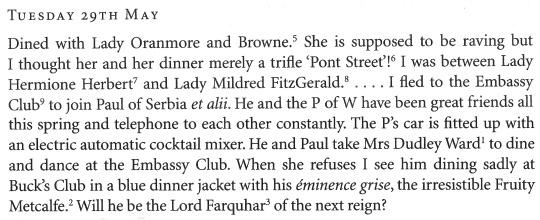
Henry ‘Chips’ Channon: The Diaries (Vol. 1), 1918-38, entry for 29th May 1923
—
Tuesday 29th May
Dined with Lady Ornamore and Browne.¹ She is supposed to be raving but I thought her and her dinner merely a trifle ‘Pont Street’!² I was between Lady Hermione Herbert³ and Lady Mildred FitzGerald.⁴ . . . . I fled to the Embassy Club⁵ to join Paul of Serbia et alii. He and the P of Wales have been great friends all this spring and telephone constantly. The P’s car is fitted up with an electric automatic cocktail mixer. He and Paul take Mrs Dudley Ward⁶ to dine and dance at the Embassy Club. When she refuses I see him dining sadly at Buck’s Club in a blue dinner jacket with his éminence grise, the irresistible Fruity Metcalfe.⁷ Will he be the Lord Farquhar⁸ of the next reign?
—
1. Olwen Verena Ponsonby (1876-1927), daughter of the 8th Earl of Bessborough, married in 1901 Geoffrey Henry Browne-Guthrie (1861-1927), 3rd Lord Ornamore and Browne and 1st Baron Mereworth.
2. Evelyn Waugh in Brideshead Revisited (1945), uses the term to indicate slightly ‘common’ behaviour by members of the upper classes; Lady Julia Flyte regards it as ‘Pont Street’ to wear a signet ring.
3. Lady Hermione Gwladys Herbert (1900-95), daughter of the 4th Earl of Powis, married in 1924 Roberto Lucchesi-Palli, 11th Duca della Grazia (1897-1979).
4. Lady Mildred Murray (1878-1969), daughter of the 7th Earl of Dunmore, married in 1919 Sir John FitzGerald Bt, MC (1884-1957), 21st Knight of Kerry.
5. Then the most exclusive nightclub in London, in Bond Street, patronised by royalty, the aristocracy and stage stars.
6. Winifred May ‘Freda’ Birkin (1895-1983), married in 1913 William Dudley Ward MP; she was mistress of the Prince of Wales from 1918 until supplanted by Mrs Simpson in 1934.
7. See entry for 14th April 1923 and footnote.
8. Horace Brand Farquhar (1844-1923), financier, had been Master of the Household to Edward VII and Steward of the Household to George V until 1922. For services rendered to both monarchs he was created a baron in 1901, advanced to a viscountcy in 1917 and an earldom in 1922. After his death he was revealed to be bankrupt. Metcalfe might well have performed similar services to Edward VIII as monarch had the King survived more than ten and a half months.
#chips channon#channon diaries#1923#1920s#olwen ornamore#hermione grazia#mildred fitzgerald#prince paul of yugoslavia#edward viii#freda dudley ward#fruity metcalfe#embassy club#buck's club#🕰️
1 note
·
View note
Text

The Universal Classic Monsters Collection will be released on 4K Ultra HD (with Digital) in digibook packaging on October 3 via Universal. Designed by Tristan Eaton, the eight-disc set is limited to 5,500.
It includes 1931's Dracula, 1931’s Frankenstein, 1932’s The Mummy, 1933’s The Invisible Man, 1935’s The Bride of Frankenstein, 1941’s The Wolf Man, 1943’s Phantom of the Opera, and 1954’s Creature from the Black Lagoon.
All eight films are presented in 4K with HDR10. The Spanish version of Dracula is also included. Special features are listed below, where you can also see more of the packaging.
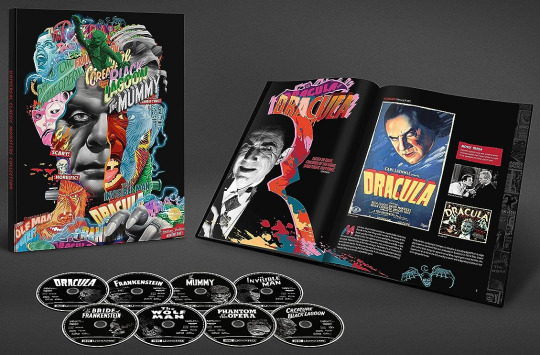
Dracula is directed by Tod Browning (Freaks) and written by Garrett Fort (Frankenstein), based on Bram Stoker’s 1897 novel. Bela Lugosi, David Manners, Helen Chandler, Dwight Frye, and Edward Van Sloan star.
Dracula special features:
Alternate score version by Philip Glass
Dracula (1931) Spanish version directed by George Melford
The Road to Dracula
Lugosi: The Dark Prince
Dracula: The Restoration
Dracula Archives
Monster Tracks
Trailer gallery
Transylvanian vampire Count Dracula bends a naive real estate agent to his will, then takes up residence at a London estate where he sleeps in his coffin by day and searches for potential victims by night.
Frankenstein is directed by James Whale (The Indivisible Man) and written by Garrett Fort (Dracula) and Francis Edward Faragoh (Little Caesar), based on Mary Shelley’s 1818 novel. Colin Clive, Mae Clarke, John Boles, and Boris Karloff star.
Frankenstein special features:
Audio commentary by film historian Rudy Behlmer
Audio commentary by historian Sir Christopher Frayling
The Frankenstein Files: How Hollywood Made A Monster
Karloff: The Gentle Monster
Universal Horror
Frankenstein Archives
Boo!: A Short Film
100 Years of Universal: Restoring the Classics
Monster Tracks
Trailer gallery
Dr. Frankenstein dares to tamper with life and death by creating a human monster out of lifeless body parts.
The Mummy is directed by Karl Freund (Dracula) and written by John L. Balderston (Dracula). Boris Karloff, Zita Johann, David Manners, Edward Van Sloan, and Arthur Byron star.
The Mummy special features:
Audio commentary by film historian Paul M. Jensen
Audio commentary by Rick Baker, Scott Essman, Steve Haberman, Bob Burns, and Brent Armstrong
Mummy Dearest: A Horror Tradition Unearthed
He Who Made Monsters: The Life and Art of Jack Pierce
Unraveling the Legacy of The Mummy
The Mummy Archives
100 Years of Universal: The Carl Laemmle Era
Trailer gallery
An Egyptian mummy searches Cairo for the girl he believes is his long-lost princess.
The Invisible Man is directed by James Whale (Frankenstein) and written by R.C. Sherriff (Goodbye, Mr. Chips), based on H.G. Wells’ 1897 novel. Gloria Stuart, Claude Rains, William Harrigan, Dudley Digges, and Una O'Connor star.
The Invisible Man special features:
Audio commentary by film historian Rudy Behlmer
Now You See Him: The Invisible Man Revealed
Production Photographs
100 Years of Universal: Unforgettable Characters
Trailer gallery
A scientist finds a way of becoming invisible, but in doing so, he becomes murderously insane.
The Bride of Frankenstein is directed by James Whale (Frankenstein) and written by William Hurlbut. Boris Karloff, Colin Clive, Valerie Hobson, and Elsa Lanchester star.
The Bride of Frankenstein special features:
Audio commentary by film historian Scott MacQueen
She’s Alive! Creating The Bride of Frankenstein
The Bride Of Frankenstein Archive
100 Years of Universal: Restoring the Classics
Trailer gallery
Dr. Frankenstein, goaded by an even madder scientist, builds his monster a mate.
The Wolf Man is directed by George Waggner (Operation Pacific) and written by Curt Siodmak (I Walked with a Zombie). Claude Rains, Warren William, Ralph Bellamy, Patric Knowles, Bela Lugosi, and Lon Chaney Jr. star.
The Wolf Man special features:
Audio commentary by film historian Tom Weaver
Monster by Moonlight
The Wolf Man: From Ancient Curse to Modern Myth
Pure in Heart: The Life and Legacy of Lon Chaney Jr.
He Who Made Monsters: The Life and Art of Jack Pierce
The Wolf Man Archives
100 Years of Universal: The Lot
Trailer gallery
Larry Talbot returns to his father's castle in Wales and meets a beautiful woman. One fateful night, Talbot escorts her to a local carnival where they meet a mysterious gypsy fortune teller.
Phantom of the Opera is directed by Arthur Lubin and written by Eric Taylor (The Ghost of Frankenstein) and Samuel Hoffenstein (Dr. Jekyll and Mr. Hyde). Claude Rains, Nelson Eddy, Susanna Foster, and Edgar Barrier star.
Phantom of the Opera special features:
Audio commentary by film historian Scott MacQueen
The Opera Ghost: A Phantom Unmasked
Production Photographs
100 Years of Universal: The Lot
Theatrical trailer
An acid-scarred composer rises from the Paris sewers to boost his favorite opera understudy’s career.
Creature from the Black Lagoon is directed by Jack Arnold (The Incredible Shrinking Man) and written by Harry Essex and Arthur A. Ross. Richard Carlson, Julia Adams, Richard Denning, Antonio Moreno, Nestor Paiva, and Whit Bissell star.
Creature from the Black Lagoon special features:
Audio commentary by film historian Tom Weaver
Back to the Black Lagoon
Production Photographs
100 Years of Universal: The Lot
Trailer gallery
A group of scientists try to capture a prehistoric creature luring in the depths of the Amazonian jungle and bring it back to civilization for study.
Pre-order Universal Classic Monsters Collection.
#universal monsters#dracula#frankenstein#the mummy#creature from the black lagoon#the wolf man#bride of frankenstein#phantom of the opera#the invisible man#horror#classic horror#dvd#gift#the bride of frankenstein#tristan eaton#wolf man
97 notes
·
View notes
Text
(Mostly) Lost, but Not Forgotten: Omar Khayyam (1923) / A Lover’s Oath (1925)

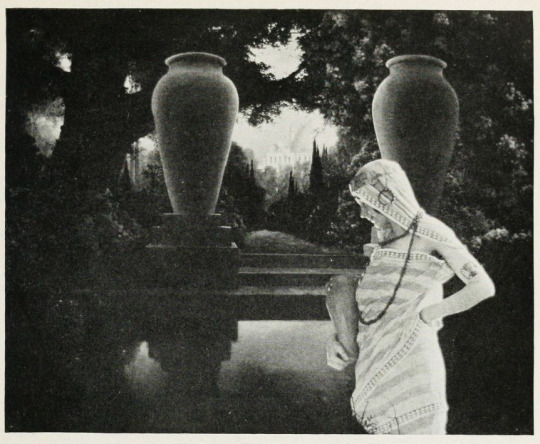
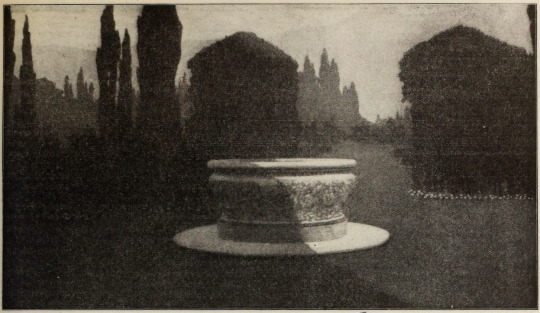

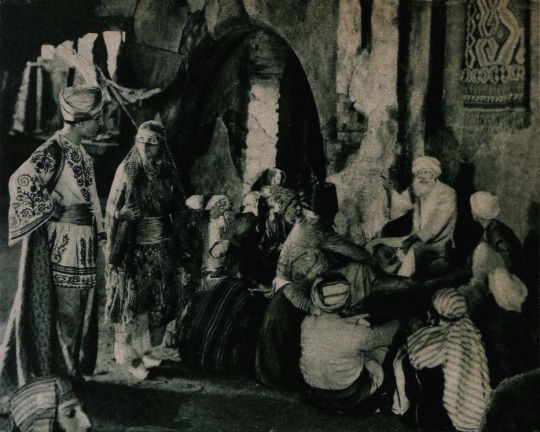


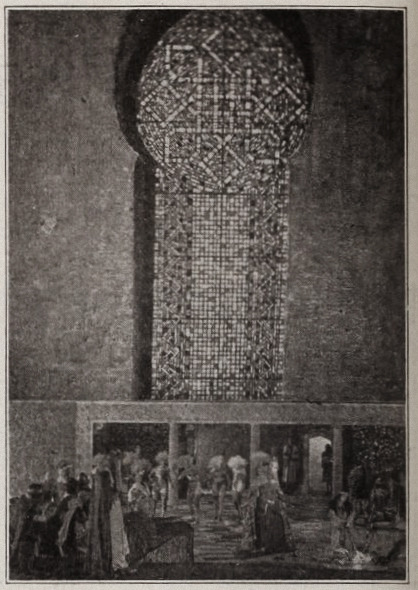
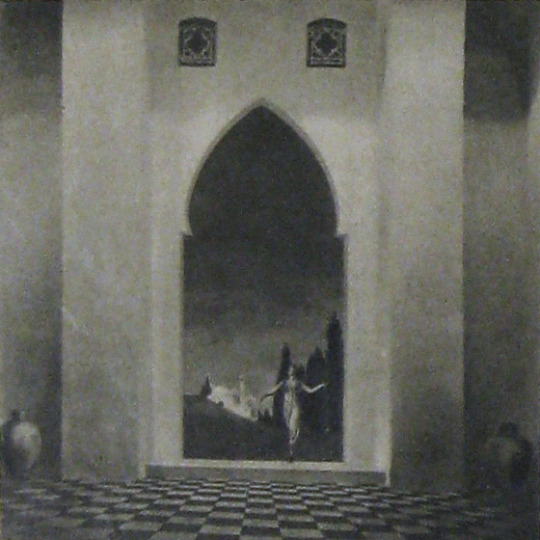



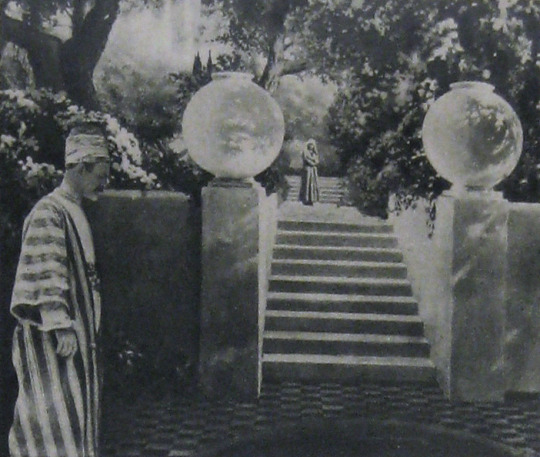
Alternate Titles: The Rubaiyat of Omar Khayyam, The Rubaiyat, Omar Khayyam, Omar
Direction: Ferdinand Pinney Earle; assisted by Walter Mayo
Scenario: Ferdinand P. Earle
Titles: Marion Ainslee, Ferdinand P. Earle (Omar), Louis Weadock (A Lover’s Oath)
Inspired by: The Rubaiyat of Omar Khayyam, as edited & translated by Edward FitzGerald
Production Manager: Winthrop Kelly
Camera: Georges Benoit
Still Photography: Edward S. Curtis
Special Photographic Effects: Ferdinand P. Earle, Gordon Bishop Pollock
Composer: Charles Wakefield Cadman
Editors: Arthur D. Ripley (The Rubaiyat of Omar Khayyam version), Ethel Davey & Ferdinand P. Earle (Omar / Omar Khayyam, the Director’s cut of 1922), Milton Sills (A Lover’s Oath)
Scenic Artists: Frank E. Berier, Xavier Muchado, Anthony Vecchio, Paul Detlefsen, Flora Smith, Jean Little Cyr, Robert Sterner, Ralph Willis
Character Designer: Louis Hels
Choreography: Ramon Novarro (credited as Ramon Samaniegos)
Technical Advisors: Prince Raphael Emmanuel, Reverend Allan Moore, Captain Dudley S. Corlette, & Captain Montlock or Mortlock
Studio: Ferdinand P. Earle Productions / The Rubaiyat, Inc. (Production) & Eastern Film Corporation (Distribution, Omar), Astor Distribution Corporation [States Rights market] (Distribution, A Lover’s Oath)
Performers: Frederick Warde, Edwin Stevens, Hedwiga Reicher, Mariska Aldrich, Paul Weigel, Robert Anderson, Arthur Carewe, Jesse Weldon, Snitz Edwards, Warren Rogers, Ramon Novarro (originally credited as Ramon Samaniegos), Big Jim Marcus, Kathleen Key, Charles A. Post, Phillippe de Lacy, Ferdinand Pinney Earle
Premiere(s): Omar cut: April 1922 The Ambassador Theatre, New York, NY (Preview Screening), 12 October 1923, Loew’s New York, New York, NY (Preview Screening), 2 February 1923, Hoyt’s Theatre, Sydney, Australia (Initial Release)
Status: Presumed lost, save for one 30 second fragment preserved by the Academy Film Archive, and a 2.5 minute fragment preserved by a private collector (Old Films & Stuff)
Length: Omar Khayyam: 8 reels , 76 minutes; A Lover’s Oath: 6 reels, 5,845 feet (though once listed with a runtime of 76 minutes, which doesn’t line up with the stated length of this cut)
Synopsis (synthesized from magazine summaries of the plot):
Omar Khayyam:
Set in 12th century Persia, the story begins with a preface in the youth of Omar Khayyam (Warde). Omar and his friends, Nizam (Weigel) and Hassan (Stevens), make a pact that whichever one of them becomes a success in life first will help out the others. In adulthood, Nizam has become a potentate and has given Omar a position so that he may continue his studies in mathematics and astronomy. Hassan, however, has grown into quite the villain. When he is expelled from the kingdom, he plots to kidnap Shireen (Key), the sheik’s daughter. Shireen is in love with Ali (Novarro). In the end it’s Hassan’s wife (Reicher) who slays the villain then kills herself.
A Lover’s Oath:
The daughter of a sheik, Shireen (Key), is in love with Ali (Novarro), the son of the ruler of a neighboring kingdom. Hassan covets Shireen and plots to kidnap her. Hassan is foiled by his wife. [The Sills’ edit places Ali and Shireen as protagonists, but there was little to no re-shooting done (absolutely none with Key or Novarro). So, most critics note how odd it is that all Ali does in the film is pitch woo, and does not save Shireen himself. This obviously wouldn’t have been an issue in the earlier cut, where Ali is a supporting character, often not even named in summaries and news items. Additional note: Post’s credit changes from “Vizier” to “Commander of the Faithful”]
Additional sequence(s) featured in the film (but I’m not sure where they fit in the continuity):
Celestial sequences featuring stars and planets moving through the cosmos
Angels spinning in a cyclone up to the heavens
A Potters’ shop sequence (relevant to a specific section of the poems)
Harem dance sequence choreographed by Novarro
Locations: palace gardens, street and marketplace scenes, ancient ruins


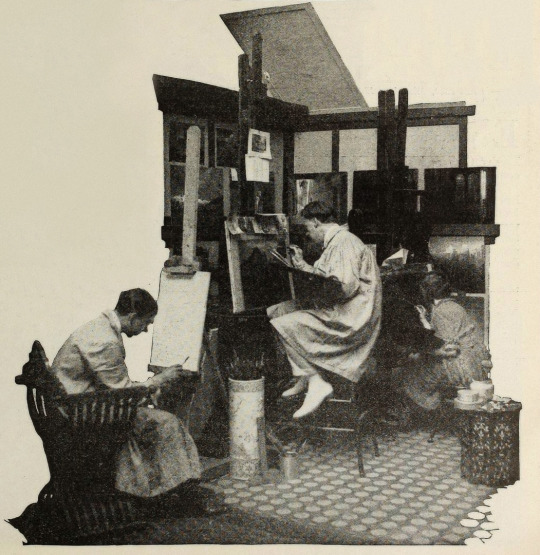


Points of Interest:
“The screen has been described as the last word in realism, but why confine it there? It can also be the last word in imaginative expression.”
Ferdinand P. Earle as quoted in Exhibitors Trade Review, 4 March 1922
The Rubaiyat of Omar Khayyam was a massive best seller. Ferdinand Pinney Earle was a classically trained artist who studied under William-Adolphe Bougueraeu and James McNeill Whistler in his youth. He also had years of experience creating art backgrounds, matte paintings, and art titles for films. Charles Wakefield Cadman was an accomplished composer of songs, operas, and operettas. Georges Benoit and Gordon Pollock were experienced photographic technicians. Edward S. Curtis was a widely renowned still photographer. Ramon Novarro was a name nobody knew yet—but they would soon enough.
When Earle chose The Rubaiyat as the source material for his directorial debut and collected such skilled collaborators, it seemed likely that the resulting film would be a landmark in the art of American cinema. Quite a few people who saw Earle’s Rubaiyat truly thought it would be:
William E. Wing writing for Camera, 9 September 1922, wrote:
“Mr. Earle…came from the world of brush and canvass, to spread his art upon the greater screen. He created a new Rubaiyat with such spiritual colors, that they swayed.”
…
“It has been my fortune to see some of the most wonderful sets that this Old Earth possesses, but I may truly say that none seized me more suddenly, or broke with greater, sudden inspiration upon the view and the brain, than some of Ferdinand Earle’s backgrounds, in his Rubaiyat.
“His vision and inspired art seem to promise something bigger and better for the future screen.”
As quoted in an ad in Film Year Book, 1923:
“Ferdinand Earle has set a new standard of production to live up to.”
Rex Ingram
“Fifty years ahead of the time.”
Marshall Neilan
The film was also listed among Fritz Lang’s Siegfried, Chaplin’s Gold Rush, Fairbanks’ Don Q, Lon Chaney’s Phantom of the Opera and The Unholy Three, and Erich Von Stroheim’s Merry Widow by the National Board of Review as an exceptional film of 1925.
So why don’t we all know about this film? (Spoiler: it’s not just because it’s lost!)
The short answer is that multiple dubious legal challenges arose that prevented Omar’s general release in the US. The long answer follows BELOW THE JUMP!
Earle began the project in earnest in 1919. Committing The Rubaiyat to film was an ambitious undertaking for a first-time director and Earle was striking out at a time when the American film industry was developing an inferiority complex about the level of artistry in their creative output. Earle was one of a number of artists in the film colony who were going independent of the emergent studio system for greater protections of their creative freedoms.
In their adaptation of The Rubaiyat of Omar Khayyam, Earle and Co. hoped to develop new and perfect existing techniques for incorporating live-action performers with paintings and expand the idea of what could be accomplished with photographic effects in filmmaking. The Rubaiyat was an inspired choice. It’s not a narrative, but a collection of poetry. This gave Earle the opportunity to intersperse fantastical, poetic sequences throughout a story set in the lifetime of Omar Khayyam, the credited writer of the poems. In addition to the fantastic, Earle’s team would recreate 12th century Persia for the screen.
Earle was convinced that if his methods were perfected, it wouldn’t matter when or where a scene was set, it would not just be possible but practical to put on film. For The Rubaiyat, the majority of shooting was done against black velvet and various matte photography and multiple exposure techniques were employed to bring a setting 800+ years in the past and 1000s of miles removed to life before a camera in a cottage in Los Angeles.
Note: If you’d like to learn a bit more about how these effects were executed at the time, see the first installment of How’d They Do That.
Unfortunately, the few surviving minutes don’t feature much of this special photography, but what does survive looks exquisite:

see all gifs here
Earle, knowing that traditional stills could not be taken while filming, brought in Edward S. Curtis. Curtis developed techniques in still photography to replicate the look of the photographic effects used for the film. So, even though the film hasn’t survived, we have some pretty great looking representations of some of the 1000s of missing feet of the film.
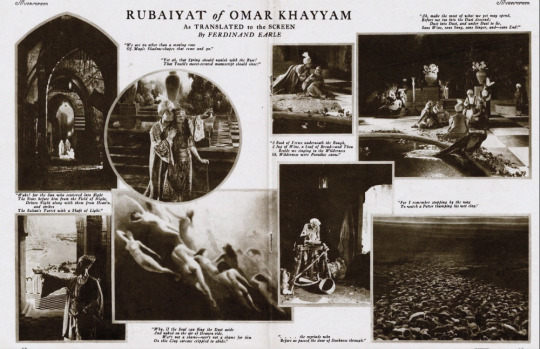
Nearly a year before Curtis joined the crew, Earle began collaboration with composer Charles Wakefield Cadman. In another bold creative move, Cadman and Earle worked closely before principal photography began so that the score could inform the construction and rhythm of the film and vice versa.
By the end of 1921 the film was complete. After roughly 9 months and the creation of over 500 paintings, The Rubaiyat was almost ready to meet its public. However, the investors in The Rubaiyat, Inc., the corporation formed by Earle to produce the film, objected to the ample reference to wine drinking (a comical objection if you’ve read the poems) and wanted the roles of the young lovers (played by as yet unknown Ramon Novarro and Kathleen Key) to be expanded. The dispute with Earle became so heated that the financiers absconded with the bulk of the film to New York. Earle filed suit against them in December to prevent them from screening their butchered and incomplete cut. Cadman supported Earle by withholding the use of his score for the film.
Later, Eastern Film Corp. brokered a settlement between the two parties, where Earle would get final cut of the film and Eastern would handle its release. Earle and Eastern agreed to change the title from The Rubaiyat of Omar Khayyam to simply Omar. Omar had its first official preview in New York City. It was tentatively announced that the film would have a wide release in the autumn.
However, before that autumn, director Norman Dawn launched a dubious patent-infringement suit against Earle and others. Dawn claimed that he owned the sole right to use multiple exposures, glass painting for single exposure, and other techniques that involved combining live action with paintings. All the cited techniques had been widespread in the film industry for a decade already and eventually and expectedly Dawn lost the suit. Despite Earle’s victory, the suit effectively put the kibosh on Omar’s release in the US.
Earle moved on to other projects that didn’t come to fruition, like a Theda Bara film and a frankly amazing sounding collaboration with Cadman to craft a silent-film opera of Faust. Omar did finally get a release, albeit only in Australia. Australian news outlets praised the film as highly as those few lucky attendees of the American preview screenings did. The narrative was described as not especially original, but that it was good enough in view of the film’s artistry and its imaginative “visual phenomena” and the precision of its technical achievement.
One reviewer for The Register, Adelaide, SA, wrote:
“It seems almost an impossibility to make a connected story out of the short verse of the Persian of old, yet the producer of this classic of the screen… has succeeded in providing an entertainment that would scarcely have been considered possible. From first to last the story grips with its very dramatic intensity.”
While Omar’s American release was still in limbo, “Ramon Samaniegos” made a huge impression in Rex Ingram’s Prisoner of Zenda (1922, extant) and Scaramouche (1923, extant) and took on a new name: Ramon Novarro. Excitement was mounting for Novarro’s next big role as the lead in the epic Ben-Hur (1925, extant) and the Omar project was re-vivified.

A new company, Astor Distribution Corp., was formed and purchased the distribution rights to Omar. Astor hired actor (note, not an editor) Milton Sills to re-cut the film to make Novarro and Key more prominent. The company also re-wrote the intertitles, reduced the films runtime by more than ten minutes, and renamed the film A Lover’s Oath. Earle had moved on by this point, vowing to never direct again. In fact, Earle was indirectly working with Novarro and Key again at the time, as an art director on Ben-Hur!
Despite Omar’s seemingly auspicious start in 1920, it was only released in the US on the states rights market as a cash-in on the success of one of its actors in a re-cut form five years later.
That said, A Lover’s Oath still received some good reviews from those who did manage to see it. Most of the negative criticism went to the story, intertitles, and Sills’ editing.
What kind of legacy could/should Omar have had? I’m obviously limited in my speculation by the fact that the film is lost, but there are a few key facts about the film’s production, release, and timing to consider.
The production budget was stated to be $174,735. That is equivalent to $3,246,994.83 in 2024 dollars. That is a lot of money, but since the production was years long and Omar was a period film set in a remote locale and features fantastical special effects sequences, it’s a modest budget. For contemporary perspective, Robin Hood (1922, extant) cost just under a million dollars to produce and Thief of Bagdad (1924, extant) cost over a million. For a film similarly steeped in spectacle to have nearly 1/10th of the budget is really very noteworthy. And, perhaps if the film had ever had a proper release in the US—in Earle’s intended form (that is to say, not the Sills cut)—Omar may have made as big of a splash as other epics.
It’s worth noting here however that there are a number of instances in contemporary trade and fan magazines where journalists off-handedly make this filmmaking experiment about undermining union workers. Essentially implying that that value of Earle’s method would be to continue production when unionized workers were striking. I’m sure that that would absolutely be a primary thought for studio heads, but it certainly wasn’t Earle’s motivation. Often when Earle talks about the method, he focuses on being able to film things that were previously impossible or impracticable to film. Driving down filming costs from Earle’s perspective was more about highlighting the artistry of his own specialty in lieu of other, more demanding and time-consuming approaches, like location shooting.
This divide between artists and studio decision makers is still at issue in the American film and television industry. Studio heads with billion dollar salaries constantly try to subvert unions of skilled professionals by pursuing (as yet) non-unionized labor. The technical developments of the past century have made Earle’s approach easier to implement. However, just because you don’t have to do quite as much math, or time an actor’s movements to a metronome, does not mean that filming a combination of painted/animated and live-action elements does not involve skilled labor.
VFX artists and animators are underappreciated and underpaid. In every new movie or TV show you watch there’s scads of VFX work done even in films/shows that have mundane, realistic settings. So, if you love a film or TV show, take the effort to appreciate the work of the humans who made it, even if their work was so good you didn’t notice it was done. And, if you’ve somehow read this far, and are so out of the loop about modern filmmaking, Disney’s “live-action” remakes are animated films, but they’ve just finagled ways to circumvent unions and low-key delegitimize the skilled labor of VFX artists and animators in the eyes of the viewing public. Don’t fall for it.
VFX workers in North America have a union under IATSE, but it’s still developing as a union and Marvel & Disney workers only voted to unionize in the autumn of 2023. The Animation Guild (TAG), also under the IATSE umbrella, has a longer history, but it’s been growing rapidly in the past year. A strike might be upcoming this year for TAG, so keep an eye out and remember to support striking workers and don’t cross picket lines, be they physical or digital!
Speaking of artistry over cost-cutting, I began this post with a mention that in the early 1920s, the American film industry was developing an inferiority complex in regard to its own artistry. This was in comparison to the European industries, Germany’s being the largest at the time. It’s frustrating to look back at this period and see acceptance of the opinion that American filmmakers weren’t bringing art to film. While yes, the emergent studio system was highly capitalistic and commercial, that does not mean the American industry was devoid of home-grown artists.
United Artists was formed in 1919 by Douglas Fairbanks, Charlie Chaplin, Mary Pickford, and D.W. Griffith precisely because studios were holding them back from investing in their art—within the same year that Earle began his Omar project. While salaries and unforgiving production schedules were also paramount concerns in the filmmakers going independent, a primary impetus was that production/distribution heads exhibited too much control over what the artists were trying to create.
Fairbanks was quickly expanding his repertoire in a more classical and fantastic direction. Cecil B. DeMille made his first in a long and very successful string of ancient epics. And the foreign-born children of the American film industry, Charlie Chaplin, Rex Ingram, and Nazimova, were poppin’ off! Chaplin was redefining comedic filmmaking. Ingram was redefining epics. Nazimova independently produced what is often regarded as America’s first art film, Salome (1923, extant), a film designed by Natacha Rambova, who was *gasp* American. Earle and his brother, William, had ambitious artistic visions of what could be done in the American industry and they also had to self-produce to get their work done.
Meanwhile, studio heads, instead of investing in the artists they already had contracts with, tried to poach talent from Europe with mixed success (in this period, see: Ernst Lubitsch, F.W. Murnau, Benjamin Christensen, Mauritz Stiller, Victor Sjöström, and so on). I’m in no way saying it was the wrong call to sign these artists, but all of these filmmakers, even if they found success in America, had stories of being hired to inject the style and artistry that they developed in Europe into American cinema, and then had their plans shot down or cut down to a shadow of their creative vision. Even Stiller, who tragically died before he had the opportunity to establish himself in the US, faced this on his first American film, The Temptress (1926, extant), on which he was replaced. Essentially, the studio heads’ actions were all hot air and spite for the filmmakers who’d gone independent.

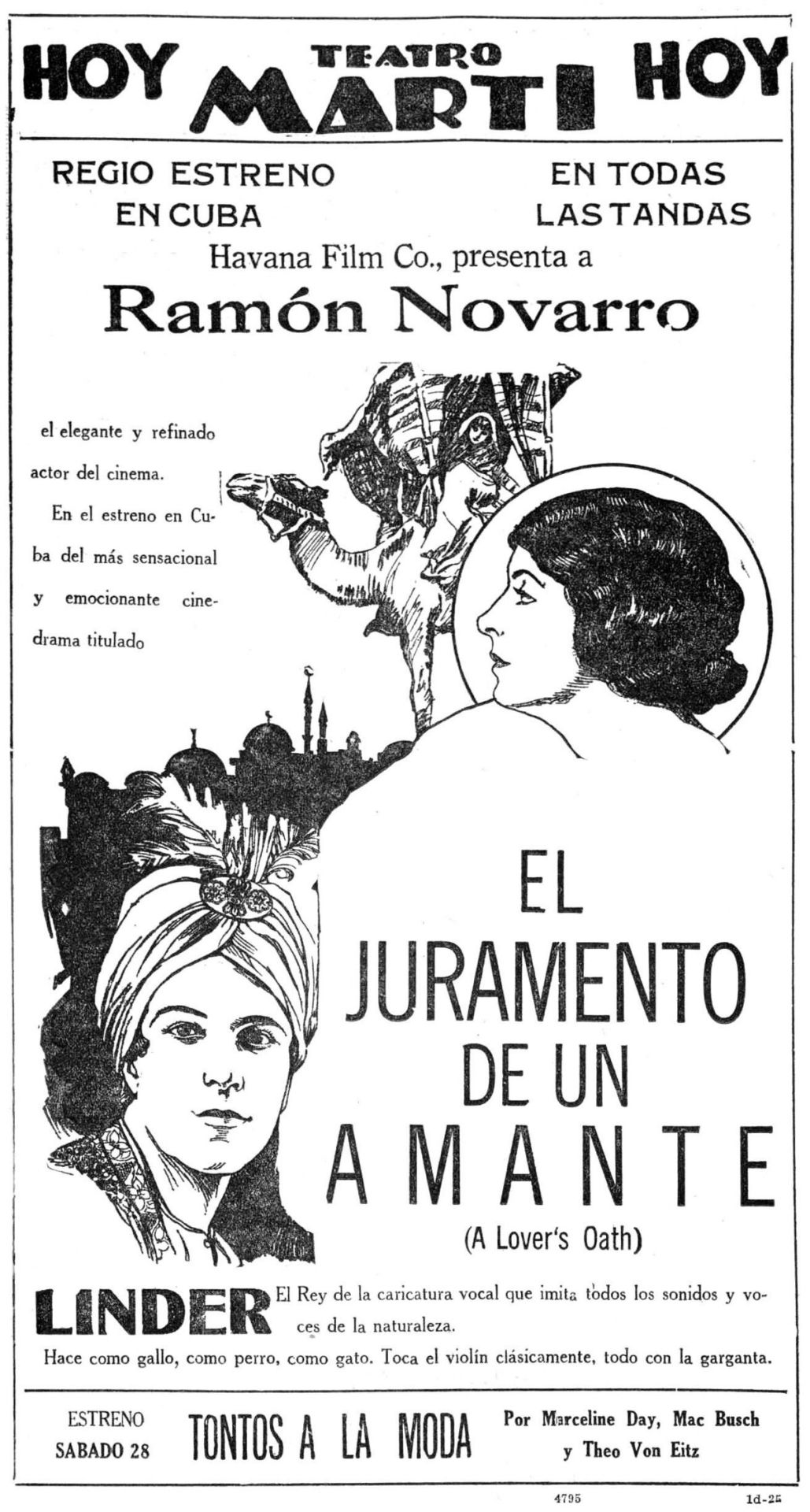
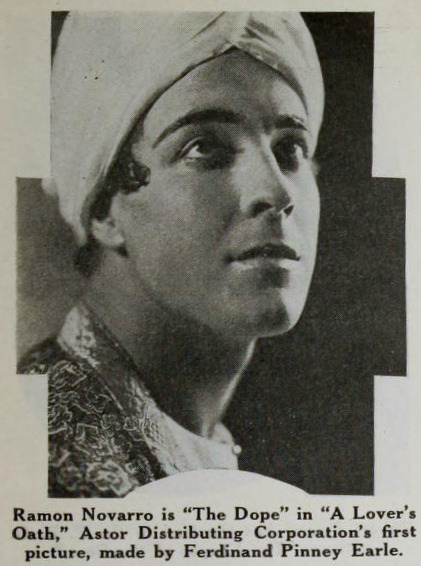
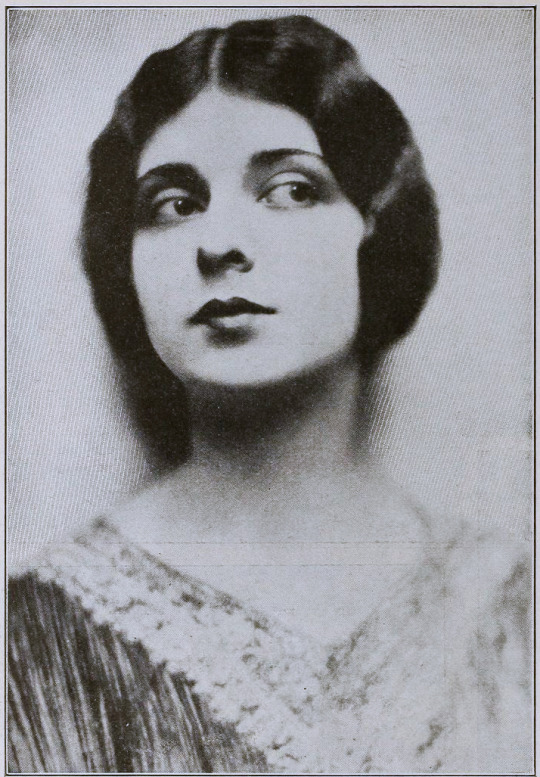
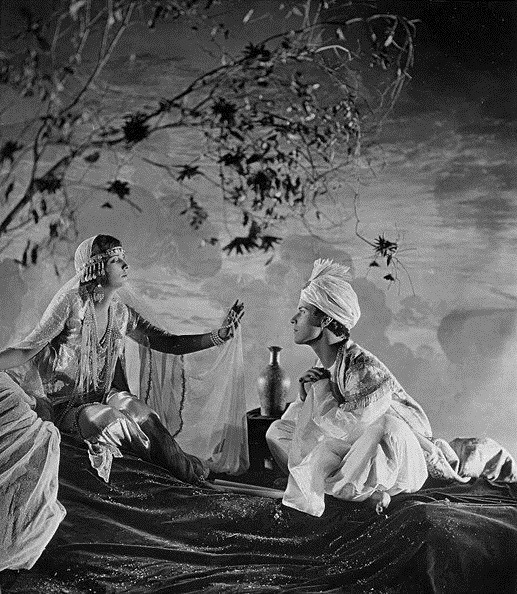
Finally I would like to highlight Ferdinand Earle’s statement to the industry, which he penned for from Camera in 14 January 1922, when his financial backers kidnapped his film to re-edit it on their terms:
MAGNA CHARTA
Until screen authors and producers obtain a charter specifying and guaranteeing their privileges and rights, the great slaughter of unprotected motion picture dramas will go merrily on.
Some of us who are half artists and half fighters and who are ready to expend ninety per cent of our energy in order to win the freedom to devote the remaining ten per cent to creative work on the screen, manage to bring to birth a piteous, half-starved art progeny.
The creative artist today labors without the stimulus of a public eager for his product, labors without the artistic momentum that fires the artist’s imagination and spurs his efforts as in any great art era.
Nowadays the taint of commercialism infects the seven arts, and the art pioneer meets with constant petty worries and handicaps.
Only once in a blue moon, in this matter-of-fact, dollar-wise age can the believer in better pictures hope to participate in a truely [sic] artistic treat.
In the seven years I have devoted to the screen, I have witnessed many splendid photodramas ruined by intruding upstarts and stubborn imbeciles. And I determined not to launch the production of my Opus No. 1 until I had adequately protected myself against all the usual evils of the way, especially as I was to make an entirely new type of picture.
In order that my film verison [sic] of the Rubaiyat of Omar Khayyam might be produced under ideal conditions and safeguarded from intolerable interferences and outside worries, I entered into a contract with the Rubaiyat, Inc., that made me not only president of the corporation and on the board of directors, but which set forth that I was to be author, production manager, director, cutter and film editor as well as art director, and that no charge could be made against the production without my written consent, and that my word was to be final on all matters of production. The late George Loane Tucker helped my attorney word the contract, which read like a splendid document.
Alas, I am now told that only by keeping title to a production until it is declared by yourself to be completed is it safe for a scenario writer, an actor or a director, who is supposedly making his own productions, to contract with a corporation; otherwise he is merely the servant of that corporation, subject at any moment to discharge, with the dubious redress of a suit for damages that can with difficulty be estimated and proven.
Can there be any hope of better pictures as long as contracts and copyrights are no protection against financial brigands and bullies?
We have scarcely emerged from barbarism, for contracts, solemnly drawn up between human beings, in which the purposes are set forth in the King’s plainest English, serve only as hurdles over which justice-mocking financiers and their nimble attorneys travel with impunity, riding rough shod over the author or artist who cannot support a legal army to defend his rights. The phrase is passed about that no contract is invioliable [sic]—and yet we think we have reached a state of civilization!
The suit begun by my attorneys in the federal courts to prevent the present hashed and incomplete version of my story from being released and exhibited, may be of interest to screen writers. For the whole struggle revolves not in the slightest degree around the sanctity of the contract, but centers around the federal copyright of my story which I never transferred in writing otherwise, and which is being brazenly ignored.
Imagine my production without pictorial titles: and imagine “The Rubaiyat” with a spoken title as follows, “That bird is getting to talk too much!”—beside some of the immortal quatrains of Fitzgerald!
One weapon, fortunately, remains for the militant art creator, when all is gone save his dignity and his sense of humor; and that is the rapier blade of ridicule, that can send lumbering to his retreat the most brutal and elephant-hided lord of finance.
How edifying—the tableau of the man of millions playing legal pranks upon men such as Charles Wakefield Cadman, Edward S. Curtis and myself and others who were associated in the bloody venture of picturizing the Rubaiyat! It has been gratifying to find the press of the whole country ready to champion the artist’s cause.
When the artist forges his plowshare into a sword, so to speak, he does not always put up a mean fight.
What publisher would dare to rewrite a sonnet of John Keats or alter one chord of a Chopin ballade?
Creative art of a high order will become possible on the screen only when the rights of established, independent screen producers, such as Rex Ingram and Maurice Tourneur, are no longer interferred with and their work no longer mutilated or changed or added to by vandal hands. And art dramas, conceived and executed by masters of screen craft, cannot be turned out like sausages made by factory hands. A flavor of individuality and distinction of style cannot be preserved in machine-made melodramas—a drama that is passed from hand to hand and concocted by patchworkers and tinkerers.
A thousand times no! For it will always be cousin to the sausage, and be like all other—sausages.
The scenes of a master’s drama may have a subtle pictorial continuity and a power of suggestion quite like a melody that is lost when just one note is changed. And the public is the only test of what is eternally true or false. What right have two or three people to deprive millions of art lovers of enjoying an artist’s creation as it emerged from his workshop?
“The Rubaiyat” was my first picture and produced in spite of continual and infernal interferences. It has taught me several sad lessons, which I have endeavored in the above paragraphs to pass on to some of my fellow sufferers. It is the hope that I am fighting, to a certain extent, their battle that has given me the courage to continue, and that has prompted me to write this article. May such hubbubs eventually teach or inforce a decent regard for the rights of authors and directors and tend to make the existence of screen artisans more secure and soothing to the nerves.
FERDINAND EARLE.
---
☕Appreciate my work? Buy me a coffee! ☕
Transcribed Sources & Annotations over on the WMM Blog!
See the Timeline for Ferdinand P. Earle's Rubaiyat Adaptation
#1920s#1923#1925#omar khayyam#ferdinand pinney earle#ramon novarro#independent film#american film#silent cinema#silent era#silent film#classic cinema#classic movies#classic film#film history#history#Charles Wakefield Cadman#cinematography#The Rubaiyat#cinema#film#lost film
41 notes
·
View notes
Text
last book, current book, next book
tagged by @grassangel
Last Book: Death and the Virgin: Elizabeth, Dudley and the Mysterious Fate of Amy Robsart, by a Tory MP (I DIDN'T KNOW). This one was okay overall but I was confused about who the target audience was supposed to be, and part of that is that most of the book isn't actually about Amy Robsart (RIP) so if she's what you picked it up for you'll have to get through a lot of stuff you already know about the Elizabeth/Leicester pairing, and it seemingly dimisses the murder idea about halfway through (she doesn't die until about page 150 or something) only to suddenly decide "well actually" in the final chapter which is too little too late for me - if I pick up a book that promises SCANDAL and MURDER then I want that to be more prominent. (I suppose this book suffers from what plagues many of those Liz/Rob OTP novels, which is that their SCANDALOUS behaviour mostly just isn't by modern standards. OH MY GOD HE TOUCHED HER HAND?! IN FRONT OF THE SPANISH AMBASSADOR?!?! *FAINTS*)
So I wouldn't really recommend that one, and not just because it was written by a Tory MP (don't worry my copy was secondhand).
Current Book(s): Current paper book is Isabella and the Strange Death of Edward II by Paul Doherty, which is full of exciting plot twists that I discussed recently, and the bit I am up to is after Hugh de Spense's been horribly killed but before Edward dies (this is not a spoiler because a) it's in the title of the book and b) this all happened in the 14th century of course he's dead by now), and currently Queen Isabella's shacked up with Roger Mortimer and ruling via her son (which is one of my favourite scheming queen tropes, yay!!) and Edward's in a castle, possibly in poor conditions, and yeah I assume he's about to get murdered and then we'll probably spend a chapter or two discussing whether or not this was Isabella's fault. OH NO, WHO HATH WROUGHT THIS TRAGIC TURN OF EVENTS?
Current Kindle book (main one, as I dip in and out of things a bit) is something about the six wives of Henry VIII by Antonia 'I'm Very Posh BTW' Fraser. Quite enjoying this one despite knowing what's going to happen to all of them. I'm only up to Anne Boleyn though and she's not even queen yet, we're still in The Interminable Divorce Proceedings which I feel is often the hardest part for a writer dealing with The Wives because it involves not much actually happening for ages and everyone gets increasingly depressed about Katherine of Aragon and then as soon as you're past THAT it's time to get depressed about Anne Boleyn. Anyway at the moment it's very awkward because Henry keeps frothing about Leviticus and how he is CURSED BY GOD because sure he has one legitimate child but she's THE WRONG SEX and this sort of thing is the reason Henry is always the least sympathetic character in any fictional version, even when they do a Bitch Anne Boleyn (oh, how edgy!). So there's a good chance I won't get to the end of this one because it's a big book with a complete shit as the 'protagonist' (it's non-fiction but u kno wot I mean) BUT in terms of the writing I'm enjoying it and it's a nice mix of Facts and Commentary so if you want a long book on this topic you could do a lot worse.
Next book(s): for paper book I plan on reading something fairly thin (because ow hand) which has maybe a 90% of being about a dead queen of England, and the next Kindle choice is further away (maybe) and will possibly depend on which Richard III biography is next to get a deep discount on Amazon.
I tag everyone, because why not?
#books and reading#history fandom#i am kind of stuck reading about kings etc because i don't feel up to anything else but at least a lot of it's entertaingly gossipy#occasionally i am forced to deal with something i actually give a fuck about like the peasant's revolt but that's usually fairly brief#like i don't really care too much if the duke of whever-the-fuckington gets stabbed in the eyes by the earl of cuntsdown#which makes up for the occasional chapter spent going “YOU LEAVE WAT TYLER ALONE YOU FUCKING PARASITE”#(obvious exception is that my Ironic Richard III Stanning has - of course! - long passed the point where Bosworth is An Proper Tragedy)
2 notes
·
View notes
Text
Thanks for the tag @isolarrwilde !
What book are you currently reading?
The House of Dudley by Joanne Paul, a new biography of the Tudor family.
What do you usually wear?
These days, jeans and more often than not a striped tshirt/top.
What's your favourite movie you've seen in theatres this year?
I haven’t been to a cinema since Bohemian Rhapsody was out. I’m not particularly interested in films.
What's your star sign? Do you share your birthday with a celebrity or historical event?
Pisces, though only just as it begins on my birthday. In Chinese astrology I’m a snake. I share my birthday with (among others) eighteenth century actor David Garrick, Anthony Stewart Head and the late Dame Gillian Lynne. Edward VI was crowned on that day in 1547 and Tchaikovsky premiered Swan Lake in 1877.
Do you go by your full name or a nick-name?
I’ve never been known by a nickname though some people have shortened it, such as my grandparents and a couple of managers at work; they're the only people I've allowed to do that as I don’t really like it being shortened unless I decide to do it myself. I’m always called by my full name within my immediate family, though my mother does have a tendency to call my sister and I pretty much anything that comes into her head. The one that’s stuck over the years is ‘Pooh’, as in Winnie The, because it rhymes with the shortened version of my name.
How tall are you?
5'3”, to my eternal chagrin as almost everyone in the family is taller than me.
Are you in a relationship? If not, who is your crush if you have one?
Nope, and no one. I assume from the latter that we’re referring to real life rather than the realms of fantasy. To be honest I can’t really see myself as part of a couple; I’ve been on my own too long and I’m pretty solitary by nature.
Did you grow up to become what you wanted to be when you were a child?
To my lasting regret I’ve never had a goal in mind and still have no idea what I'm doing with my life.
If you draw/write/create in any way, what's your favourite picture/line/etc. from something you created this year?
I've written so much this year (just under 300K words - eek!) I doubt I could pick one line! As for art, I'm very fond of this Bush sketch from earlier in the year; for once I managed to get the expression and head tilt right:

Dogs or cats?
In the past I would always have said dogs, but just lately I’ve found myself coming round to cats after previously having been quite anti. Dogs probably still win out, though.
What's something you're good at vs. something you're bad at?
I'm very good at judging distances, but I can't whistle to save my life.
What's something you'd like to create content for?
I don’t really think I would. I’ve been asked on the odd occasion if things of mine can be included in zines but I’ve never accepted.
What's something you're currently obsessed with?
My eighteenth century fixation is still going strong after more than thirty years, and my Hornblower phase mark II hasn’t come to an end yet.
What's something that you were excited about that turned out to be disappointing this year?
I haven't really had anything to get excited about for a long time. It was annoying that the Christmas event at Mottifont Abbey was so busy first thing on a Monday morning; that was disappointing, I suppose.
What's a hidden talent of yours?
It's not a talent as such but I have a great facility for remembering lines from comedy shows, though I wouldn't exactly call it hidden as I know I have an annoying tendency to quote them all the time. I actually can't think of anything I'd regard as a 'hidden talent'.
Are you religious?
For many years I would have immediately described myself as an atheist but as I get older I find myself less sure and am now agnostic. I’ve started to find the religious aspect of Christmas comforting, something that I think probably started during the pandemic, though I wouldn’t call myself a believer in any real sense.
What's something you wish to have at this moment?
Just at this minute, I would dearly love the tension headache that has been plaguing me for weeks to leave me alone. In the long term, a job, and preferably one I actually enjoy doing after spending far too long in a position I came to detest.
Tagging @amalthea9 @ariel-seagull-wings @aragarna @gone-grl-gone @sirastar and anyone else who fancies it!
9 notes
·
View notes
Text
DEATH OF AN ANOINTED KING:
THE ASSASSINATION OF HENRY VI OF ENGLAND.

“The Croyland Chronicle condemned the 'tyrant' who 'dared to lay sacrilegious hands on the Lord's Anointed' and by June word had reached France that Edward had 'caused King Henry to be secretly assassinated in the Tower... He has, in short, chosen to crush the seed.’
The Warkworth Chronicle, written no later than 1484, noted suggestively that when Henry died he was kept company in the Tower by 'the duke of Gloucester', Edward's youngest brother and the man who had only a few weeks before condemned most of Henry's surviving commanders to execution in Tewksbury. But Gloucester was certainly not alone in the Tower.
At one point during Fauconberg's rebellion, the lieutenant of the Tower, the septuagenarian Lord Dudley, was commanding a hundred soldiers there and thirty-six men are named as being in attendance on Henry during his last imprisonment. Any one of these men might have been Henry's murderer.
Even the exact cause of Henry's death was unclear. A legend soon arose that Henry had been stabbed. However, when his body was exhumed in 1910, the skull was found to be 'apparently matted with blood' and broken in several places. He may therefore have died from a blow to the head.
What is certain is that in spite of the legends that later wove themselves around Richard, duke of Gloucester, connecting his hand with Henry's death, the ultimate responsibility for it lay with Edward IV.
As constable of England, Gloucester was responsible for imparting royal justice and may have carried a royal command for Henry's death. But that order had to come from Edward.
Whatever befell Henry the night before, on the morning of 22 May 1471 his body was embalmed with wax and spices, then wrapped in linen for burial.
But before he could be laid to rest there was one last forced procession he had to make. To prove, once and for all, that the House of Lancaster was defeated, Henry's corpse was loaded on to a wagon to wind its way through London's streets to St Paul's Cathedral, surrounded by torchbearers and soldiers.
For a few days he was left on display in the cathedral, his unseeing face open to public scrutiny. As his body lay on the pavement of the church it was seen to bleed, a sign that was generally understood to indicate that Henry had been murdered.”
JOHNSON, Lauren. “Shadow King: Life and Death of Henry VI”
#house of Lancaster#plantagenet dynasty#Henry VI of England#Henry VI#Edward IV#Richard III#kingslaying#war of the roses#cousins’s war
6 notes
·
View notes
Text
🖼 The Execution of Lady Jane Grey d.1833 by Paul Delaroche.
📍 National Gallery, London, UK.
📖 On this day in 1533, Lady Jane Grey was executed on charges of high treason. With the young King Edward VI falling ill, in an effort to maintain the English Reformation and prevent his Catholic half-sister, Mary from ascending the throne, in his will he named his first cousin, Lady Jane Grey as heir. Jane was a committed Protestant who would maintain the Church of England. Edward's will completely wiped the succession of his sisters, Mary and Elizabeth, on account of their illegitimacy, a repeal of the Third Succession Act of 1543.
After Edward's death, Jane was named Queen on the 10th of July, 1533 and awaited Coronation at the Tower of London. However, support for Mary to ascend the throne grew quickly and Jane lost her supporters, as the Privy Council aligned with Mary. Jane was swiftly deposed within 9 days (she is commonly referred to as the '9 days Queen') and Mary was proclaimed Queen on the 19th July, 1533. Jane, her husband, Lord Dudley and her father-in-law, the Duke of Northumberland were all sentence to high treason.
The Duke of Northumberland was swiftly executed a month later, while Jane remained a prisoner. Mary intended to spare her life, but she became a threat to the Crown when her Jane's father, the Duke of Suffolk became engaged in the Wyatt Rebellion in January 1554. It was a rebellion against Mary's intention to marry Philip of Spain, a move with would only entrench Catholic hold on the throne. Jane and her husband, Lord Dudley were both executed on the 12th of February, 1554.
The painting was painted some 300 years after the event, but Delaroche had gained a reputation at the Paris Salon for his realistic portrayals of historical events. Despite this, there are some inaccuracies. It shows the moment where a blindfolded Jane is reaching for the block to lay her head. The Baron Chandos assists her, the Lieutenant at the Tower. Jane is surrounded by a couple of ladies in waiting, who convey their grief at what is about to happen. The execution did in fact take place outside, on the Tower Green, yet clearly the painting depicts an indoor scene. The wooden platform the execution is taking place on is based on one more commonly seen in the French Revolution.

#art#art history#history#tudor history#english history#english reformation#lady jane grey#painting#paul delaroche#national gallery
5 notes
·
View notes
Photo


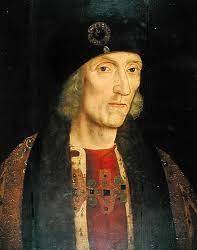

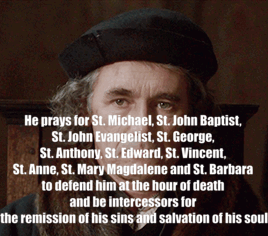
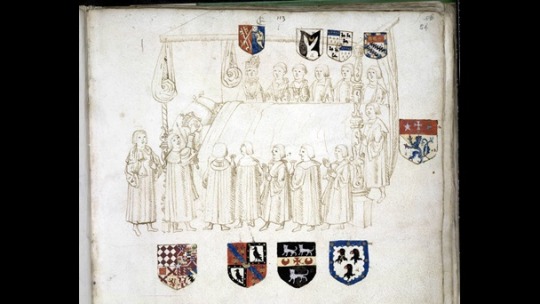
“Will of Henry VII”.
“At his manor of Richmond, 31 March Hen. VII., the King makes his last will, commending his soul to the Redeemer with the words he has used since his first "years of discretion," Domine Jesu Christe, qui me ex nichilo creasti, fecisti, redemisti et predestinasti ad hoc quod sum, Tu scis quid de me facere vis, fac de me secundum voluntatem Tuam cum misericordia, trusting in the grace of His Blessed Mother in whom, after Him, has been all his (testator's) trust, by whom in all his adversities he has had special comfort, and to whom he now makes his prayer (recited), as also to all the company of Heaven and especially his "accustumed avoures" St. Michael, St. John Baptist, St. John Evangelist, St. George, St. Anthony, St. Edward, St. Vincent, St. Anne, St. Mary Magdalene and St. Barbara, to defend him at the hour of death and be intercessors for the remission of his sins and salvation of his soul.
Desires to be buried at Westminster, where he was crowned, where lie buried many of his progenitors, especially his granddame Katharine wife to Henry V. and daughter to Charles of France, and whereto he means shortly to translate the remains of Henry VI.,—in the chapel which he has begun to build (giving full directions for the placing and making of his tomb and finishing of the said chapel according to the plan which he has "in picture delivered" to the prior of St. Bartholomew's beside Smithfield, master of the works for the same); and he has delivered beforehand to the abbot, &c., of Westminster, 5,000l., by indenture dated Richmond, 13 April 23 Hen. VII., towards the cost.
His executors shall cause 10,000 masses in honor of the Trinity, the Five Wounds, the Five Joys of Our Lady, the Nine Orders of Angels, the Patriarchs, the Twelve Apostles and All Saints (numbers to each object specified) to be said within one month after his decease, at 6d. each, making in all 250l., and shall distribute 2,000l. in alms; and to ensure payment he has left 2,250l. with the abbot, &c., of Westminster, by indenture dated _ (blank) day of _ (blank) in the _ (blank) year of his reign.
His debts are then to be paid and reparation for wrongs made by his executors at the discretion of the following persons, by whom all complaints shall be tenderly weighed, viz., the abp. of Canterbury, Richard bp. of Winchester, the bps. of London and Rochester, Thomas Earl of Surrey, Treasurer General, George Earl of Shrewsbury, Steward of the House, Sir Charles Somerset Lord Herbert, Chamberlain, the two Chief Justices, Mr. John Yong, Master of the Rolls, Sir Thos. Lovell, Treasurer of the House, Mr. Thomas Routhall, secretary, Sir Ric. Emson, Chancellor of the Duchy, Edm. Dudley, the King's attorney at the time of his decease, and his confessor, the Provincial of the Friars Observants, and Mr. William Atwater, dean of the Chapel, or at least six of them and three of his executors.
His executors shall see that the officers of the Household and Wardrobe discharge any debts which may be due for charges of the same. Lands to the yearly value of above 1,000 mks. have been "amortised" for fulfilment of certain covenants (described) with the abbey of Westminster.
For the completion of the hospital which he has begun to build at the Savoie place beside Charingcrosse, and towards which 10,000 mks. in ready money has been delivered to the dean and chapter of St. Paul's, by indenture dated _ (blank), his executors shall deliver any more money which may be necessary; and they shall also make (if he has not done it in his lifetime) two similar hospitals in the suburbs of York and Coventry.
Certain cathedrals, abbeys, &c., named in a schedule hereto annexed [not annexed now] have undertaken to make for him orisons, prayers and suffrages "while the world shall endure," in return for which he has made them large confirmations, licences and other grants; and he now wishes 6s. 8d. each to be delivered soon after his decease to the rulers of such cathedrals, &c., 3s. 4d. to every canon and monk, being priest, within the same and 20d. to every canon, monk, vicar and minister not being priest.
His executors shall bestow 2,000l. upon the repair of the highways and bridges from Windsor to Richmond manor and thence to St. George's church beside Southwark, and thence to Greenwich manor, and thence to Canterbury.
To divers lords, as well of his blood as other, and also to knights, squires and other subjects, he has, for their good service, made grants of lands, offices and annuities, which he straitly charges his son, the Prince, and other heirs to respect; as also the enfeoffments of the Duchy of Lancaster made by Parliaments of 7 and 19 Hen. VII. for the fulfilment of his will.
Bequests for finishing of the church of the New College in Cambridge and the church of Westminster, for the houses of Friars Observants, for the altar within the King's grate (i.e. of his tomb), for the high altar within the King's chapel, for the image of the King to be made and set upon St. Edward's shrine, for the College of Windsor, for the monastery of Westminster, for the image of the King to be set at St. Thomas's shrine at Canterbury, and for chalices and pixes of a certain fashion to be given to all the houses of Friars and every parish church not suitably provided with such.
Bequest of a dote of 50,000l. for the marriage of Lady Mary the King's daughter with Charles Prince of Spain, as contracted at Richmond _ (blank) Dec. 24 Hen. VIII., or (if that fail) her marriage with any prince out of the realm by "consent of our said son the Prince, his Council and our said executors."
Executors of this will shall be Margaret Countess of Richmond, the King's mother, Christopher abp. of York, Richard bp. of Winchester*, Richard bp. of London*, Edmond bp. of Salisbury, William bp. of Lincoln, John bp. of Rochester*, Thomas Earl of Arundel, Thomas Earl of Surrey, Treasurer General, Sir Charles Somerset Lord Herbert*, Chamberlain, Sir John Fyneux*, Chief Justice, Sir Robert Rede*, Chief Justice of C.P., Mr. John Yong*, M.R., Sir Thomas Lovell, Treasurer of Household, Mr. Thomas Rowthale*, Secretary, Sir Richard Emson*, Chancellor of the Duchy of Lancaster, Sir John Cutte, Under-Treasurer General, and Edmond Dudley*, squire, of whom those marked (*) above (or seven of them) are to assemble at least once in every term for twelve days, and declare annually their account to the supervisor of this will hereby appointed, viz. the abp. of Canterbury for the time being.
On assuming the administration, the supervisor and the executors named as "superattenders" (those marked with * above) shall each receive 100l. in half yearly instalments of 50 mks.; and when the will has been fully executed they shall each receive 200l. and the other executors 100l.
Dated at [Ca]unterbury the [10th day] (fn. 3) of April 24 Hen. VII.”
Link: https://www.british-history.ac.uk/letters-papers-hen8/vol1/pp1-8
Fancast: Mark Rylance as older Henry VII. Gifs are not mine to claim, they are used to illustrate the character.
#Henry VII#Henry Tudor#Henry VII of England#King Henry VII of England#House of Tudor#Tudor dynasty#The Tudors#Tudor#Tudor England#religiosity in Tudor England#Catholic Church#Catholic Saints#will of a dying king#Margaret Beaufort#Edmund Dudley#Richard Empson#Charles Somerset#primary sources#Mark Rylance
18 notes
·
View notes
Text
Current Favorite Songs Meme
I was tagged by the lovely and talented @royaltyisshe64. Going for four categories because I’m that kind of person: popular, jazz, soundtrack/showtune, and classical.
POPULAR
“Tell Me Why” - The Beatles
“O Captain My Captain” - David Broza
“I Give You Give Blind” - Crosby, Stills, and Nash
“Sultans of Swing” - Dire Straits
“The Art of Dying” - George Harrison
“Night in the City” - Joni Mitchell
“Game of Love” - Katrina and the Waves
“Luckie” - Laura Nyro
“Calico Skies” - Paul McCartney
“‘39″ - Queen
JAZZ
“Plea for Peace” - The Afro-Semitic Experience
“My Favorite Things” - Dave Brubeck
“De-Lovely” - Ella Fitzgerald
“A Nightingale Sang in Berkeley Square” - Glenn Miller Orchestra
“What a Wonderful World” - Louis Armstrong
“Popsicle Toes” - Michael Franks
“So What” - Miles Davis
“Pirate Jenny” - Nina Simone
“Somebody Loves Me” - Oscar Peterson
“Night for Crying” - Tim Weisberg
SOUNDTRACK/SHOWTUNE
“At The Ballet” - OBC, “A Chorus Line”
“Livin’ It Up on Top” - OBC, “Hadestown”
“Non Nobis Domine” - soundtrack from “Henry V” by Patrick Doyle
“The Daily Grind” - soundtrack from “Jeeves and Wooster” by Anne Dudley
”More and More” - Dudu Fisher and Ruthie Henshall, “Kol Nidrei””
“Overture/Main Titles” - soundtrack from “Lawrence of Arabia” by Maurice Jarre
“Main Title” - soundtrack from “The Lion in Winter” by John Barry
“People Will Say We’re In Love” - Maureen Lipman and Hugh Jackman, “Oklahoma”
“My Man’s Gone Now” - Leontyne Price, “Porgy and Bess”
CLASSICAL
“Concerto for Violin” - Samuel Barber/Joseph Silverstein and the Utah Symphony
“Concerto for Violin and Cello” - Johannes Brahms/Nathan Milstein and Gregor Piatigorsky
“I Bought Me a Cat” - Aaron Copland/William Warfield
“Captaine Digorie Piper, His Galliard” - John Dowland/Consort of Musicke
“Sonata for Cello” - Edward Elgar/Steven Isserliss
“Sonata for Violin” - Cesar Franck/Augustin Hadelich
“Romeo and Juliet” - Sergei Prokofiev/Berlin Philharmonic
“The Rite of Spring” - Igor Stravinskky/Zubin Mehta and the New York Philharmonic
“Reconciliation” (from “Dona Nobis Pacem”) - Ralph Vaughan Williams/Brian Rayner Cook, Edith Wiens, and the London Philharmonic Chorus & Orchestra
“The Saga of Jenny” - Kurt Weill/Dawn Upshaw
5 notes
·
View notes
Text
RWBY: The Holiday Special
Taking place after the series, we get a look at what the holiday season is like on Remnant.
Starring the voices of:
Lindsay Jones as Ruby Rose
Kara Eberle as Weiss Schnee
Arryn Zech as Blake Belladonna
Barbara Dunkelman as Yang Xiao Long
Cast:
Dawn M. Bennett as Elm Ederne
Jen Brown as Pyrrha Nikos
Sena Bryer as May Marigold
Ashley Burns as Coco Adel
Burnie Burns as Taiyang Xiao Long
Tiana Camacho as Glynda Goodwitch
Cam Clarke as Bartholomew Oobleck
Colleen Clinkenbeard as Jinn
Amber Lee Connors as Vernal
Aaron Dismuke as Oscar Pine
Michele Everheart as Fiona Thyme
Dave Fennoy as Dr. Pietro Polendina
Gavin Free as Scarlet David
Caitlin Glass as Willow Schnee
Anna Hullum as Raven Branwen
Samantha Ireland as Nora Valkyrie
Michael Jones as Sun Wukong
Mick Lauer as Marrow Amin
Morgan Lauré as Summer Rose
Cherami Leigh as Ilia Amitola
Marissa Lenti as Joanna Greenleaf
Jason Liebrecht as Qrow Branwen
Yuri Lowenthal as Mercury Black
Miles Luna as Jaune Arc
Joe MacDonald as Yatsuhashi Daichi
Aaron Marquis as Nolan Porfirio
Penny Layne Matthews as Zwei
Elizabeth Maxwell as Winter Schnee
Shannon McCormick as Professor Ozpin
Taylor McNee as Penny Polendina
Lani Minella as Rowena Sunnybrook
Max Mittelman as Fox Alistair
Katie Newville as Emerald Sustrai
Jessica Nigri as Cinder Fall
William Orendorff as Hazel Rainart
Josh Ornelas as Sage Ayana
Neath Oum as Lie Ren
Tara Platt as Kali Belladonna
Anairis Quiñones as Harriet Bree
Jason Rose as James Ironwood
Anthony Sardinha as Peter Port
Kerry Shawcross as Neptune Vasilias
Keith Silverstein as Professor Theodore
Melissa Sternenberg as Maria Calavera
Valentine Stokes as Ambrosius
Karen Strassmann as Gretchen Rainart
J. Michael Tatum as Klein Sieben
Cristina Vee as Robyn Hill
Howard Wang as Whitley Schnee
Caiti Ward as Velvet Scarlatina
Christopher Wehkamp as Clover Ebi
Casey Lee Williams as singing voice of Weiss Schnee & Neopolitan
Kent Williams as Ghira Belladonna
Todd Womack as Vine Zeki
Anne Yatco as Xanthe Rumpole
Additional Voices:
Orion Acaba as Harold Mulberry
César Altagracia as Crimson
Amalee as Ivy Thickety
Yssa Badiola as Ciel Soleil
Laura Bailey as Amber
William Ball as Saber Rodentia
Ryan Bartley as Arslan Altan
Eric Baudour as Forest
Brian Beacock as Roch Szalt
Dawn M. Bennett as An Ren
Laila Berzins as Starr Sanzang
Grace Bono as Nebula Violette
Jen Brown as Red Haired Woman & Lisa Lavender
Reba Buhr as Lily’s Younger Sister
Billy B. Burson III as Branwen Bandit 2
Paige Campbell as Dew Gayl
Bruce Carey as Captain
Dani Chambers as Iris Marilla
Clifford Chapin as Shay D. Mann
Luci Christian as Lil’ Miss Malachite & Fria
Greg Chun as Green
Lucella Wren Clary as Adrian Cotta-Arc
Alfred Coleman as Merchant
Kate Daigler as Atlas Soldier Officer
Adam Ellis as Cardin Winchester & Tukson
Dorothy Fahn as Slate
Melissa Fahn as Lily
Erin Fitzgerald as Rae Noire
Flynt Flossy as Flynt Coal
Jim Foronda as Russet Ka
Sandy Fox as Ariadne Guime
Scott Frerichs as Mata
Grant George as Ivori
Blaine Gibson as Brawnz Ni
Christopher Guerrero as Dudley & Blacksmith
Claire Hogan as Octavia Ember
Victoria Holden as Mata’s Mother
Xanthe Huynh as Claret Berbere
Chad James as Asher Mora & Councilman Sleet
Chris Kokkinos as Fenix Nemean, Spider Bodyguard 2, Branwen Bandit 1, & Crew Member 2
Anjali Kunapaneni as Cye Ayu
Skye Lafontaine as Olive Harper
Aleks Le as Nadir Shiko
Judy Alice Lee as Ruda Tilleroot
Mela Lee as Caroline Cordovin
Marissa Lenti as Oscar’s Aunt
Alex Mai as Dee
Joel Mann as Drunk Mann
Bryan Massey as Bertilak Celadon
Dustin Matthews as Drinking Buddy
Kyle McCarley as Sky Lark
Mike McFarland as Mayor
Daman Mills as Leonardo Lionheart
Ryan Mitchum as August Caspian
Cassandra Lee Morris as Kandi Floss
Kim Newman as Higanbana Waitress
Richard Norman as Fenix Atar
Brooke Olson as Mantle Child
Colleen O’Shaughnessey as Thumbelina Peach
Bryce Papenbrook as Russel Thrush
Jack Pattillo as Hei “Junior” Xiong
Paul St. Peter as Edward Caspian
Kyle Phillips as Nubuck Guards
Anairis Quiñones as Councilwoman Camilla
Eden Riegel as Elektra Fury
Sam Riegel as Finn Asturias
Jon Risinger as Bolin Hori
Cindy Robinson as Ann Greene
Patrick Rodriguez as Shopkeep & Cyril Ian
Kristi Rothrock as Zure Ayu
Andrew Russell as Kobalt
Ian Russell as Mossius Berbere
Alejandro Saab as Dove Bronzewing & Henry Marigold
Lindsay Seidel as May Zedong
Kerry Shawcross as Pyke Rite
Lindsay Sheppard as Saphron Cotta-Arc
Michael Sinterniklaas as Roy Stallion
Jamie Smith as Terra Cotta-Arc
Gus Sorola as Fiona’s Uncle
Laura Stahl as Roane Ashwood
Christine Stuckart as Grandmother
Kaiji Tang as Li Ren
Jenn K. Tidwell as Mother & Spider Bodyguard 1
Alexis Tipton as Bianca Prisma
Maggie Tominey as Miltia & Melanie Malachite
Meg Turney as Neon Katt
Natalie Van Sistine as Cerise Claire
Erin Winn as Reese Chloris
Kimberly Woods as Olive Gashley
Yunhao Xhong as Crew Member 1
Laura Yates as Arrastra Skye
Christian Young as Rhodes
Mylissa Zelechowski as Gwen Darcy
Molly Zhang as Mikado Lem
Derreck Ziegler as Matte Skye
#rwby#rwby: the holiday special#team remnant#the remnant alliance#merry christmas#happy holidays#monty oum#miles luna#kerry shawcross#eddy rivas#kiersi burkhart#Spotify
0 notes
Text
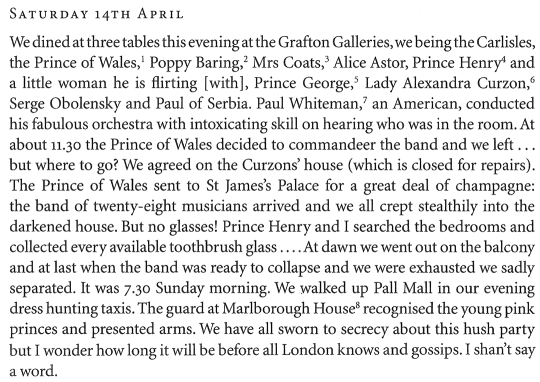
Henry ‘Chips’ Channon: The Diaries (Vol. 1), 1918-38, entry for 14th April 1923
—
Saturday 14th April
We dined at three tables this evening at the Grafton Galleries, we being the Carlisles, the Prince of Wales,¹ Poppy Baring,² Mrs Coats,³ Alice Astor, Prince Henry⁴ and a little woman he is flirting [with], Prince George,⁵ Lady Alexandra Curzon,⁶ Serge Obolensky and Paul of Serbia. Paul Whiteman,⁷ an American, conducted his fabulous orchestra with intoxicating skill on hearing who was in the room. At about 11.30 the Prince of Wales decided to commandeer the band and we left . . . but where to go? We agreed on the Curzons’ house (which is closed for repairs). The Prince of Wales sent to St James Palace for a great deal of champagne: the band of twenty-eight musicians arrived and we all crept stealthily into the darkened house. But no glasses! Prince Henry and I searched the bedrooms and collected every available toothbrush glass . . . . At dawn we went out on the balcony and at last when the band was ready to collapse and we were exhausted we sadly separated. It was 7.30 Sunday morning. We walked up Pall Mall in our evening dress hunting taxis. The guard at Marlborough House⁸ recognised the young pink princes and presented arms. We have all sworn to secrecy about this hush party but I wonder how long it will be before all of London knows and gossips. I shan’t say a word.
—
1. Prince Edward Albert Christian George Andrew Patrick David (1894-1972), elder son of King George V and Queen Mary, created Prince of Wales 1911; succeeded his father in January 1936 as King Edward VIII, abdicated December 1936; created Duke of Windsor on his abdication; married Wallis Warfield Simpson (1896-1986), of Baltimore, in 1937.
2. Helen Azalea ‘Poppy’ Baring (1901-80), daughter of Sir Godfrey Baring Bt, and Eva Hermione Mackintosh: the Duke of York had proposed to her in 1921 but his mother, Queen Mary, had forbidden the union because of her supposed unsuitability. She was also vetoed as a bride for Prince George, whose mistress she became. She married William Piers Thursby (1904-77) in 1928. She ran a dress shop in Down Street, off Piccadilly in London.
3. Audrey Evelyn James (1902-68), daughter of William Dodge James, married in 1922 Captain Muir Dudley Coats MC (1897-1927) of the Scots Guards. Having been widowed she married in 1930 Marshall James Field (1893-1956), an American department-store heir, investment banker and newspaper proprietor. They divorced in 1934.
4. Prince Henry William Frederick Albert (1900-74), third son of King George V and Queen Mary, created Duke of Gloucester 1928; married in 1935 Lady Alice Christabel Montagu Douglas Scott (1901-2004), daughter of the 7th Duke of Buccleuch.
5. Prince George Edward Alexander Edmund (1902-42), fourth son of King George V and Queen Mary, created Duke of Kent 1934; married in 1934 Princess Marina of Greece and Denmark (1906-68). Although known before his marriage to have had a number of mistresses he was also believed to be bisexual, and became one of Channon’s closest friends. He was killed on active service with the RAF when his flying boat crashed into a hillside in Caithness.
6. Lady Alexandra Naldera ‘Baba’ Curzon (1904-95), Lord Curzon’s youngest daughter by his first marriage. In 1925 she married Major Edward Dudley ‘Fruity’ Metcalfe (1887-1957), confidant and equerry of the future King Edward VIII, but conducted a number of affairs with men in high society, notably Lord Halifax, between the wars. Because of her flirtations with various fascists in the 1930s her nickname morphed into ‘Baba Blackshirt’.
7. Paul Samuel Whiteman (1890-1967) was one of America’s most famous band leaders.
8. Residence of Queen Alexandra in her widowhood.
#chips channon#channon diaries#1923#1920s#george carlisle#biddy carlisle#edward viii#poppy thursby#audrey james#alice astor#prince henry duke of gloucester#prince george duke of kent#baba metcalfe#prince serge obolensky#prince paul of yugoslavia#paul whiteman#grafton galleries#marlborough house#🕰️
1 note
·
View note
Photo

William Holden and June Allyson in Executive Suite (Robert Wise, 1954)
Cast: William Holden, June Allyson, Barbara Stanwyck, Fredric March, Walter Pidgeon, Louis Calhern, Paul Douglas, Shelley Winters, Nina Foch, Dean Jagger, Tim Considine. Screenplay: Ernest Lehman, based on a novel by Cameron Hawley. Cinematography: George J. Folsey. Art direction: Edward C. Carfagno, Cedric Gibbons. Film editing: Ralph E. Winters.
It has been called "Grand Hotel in the boardroom" more than a few times, because what it has in common with Edmund Goulding's 1932 best picture winner is that it was made by MGM and features an all-star cast. Executive Suite doesn't have much else in common with the earlier film, which was an entertaining stew of intrigue among the glamorous guests of a Berlin hotel. This is a story about power plays in a Pennsylvania furniture manufacturing company, which is about as glamorous as it sounds. The company's president has died without leaving a designated successor. We even see him die -- or rather, we die with him, as the film opens with a subjective camera as Avery Bullard leaves his Manhattan office to take a plane to Pennsylvania for a meeting with his vice-presidents. Through his eyes we see employees greet him as he leaves his office, the elevator doors closing on him, and finally the sidewalk as he collapses from a stroke. A passerby filches the wallet he drops, empties it of cash, and tosses it in a trashcan, thereby postponing the identification of his body. So much for any real action in the movie: The rest is talk, as the company's vice-presidents gather for the meeting and then gradually learn of his death. But one person knew of Bullard's death before them: George Caswell (Louis Calhern), a member of the company's board of directors who from his office window saw Bullard's body taken away by an ambulance and now uses this knowledge to try to pull a fast one with the company's stock. Eventually, there will be a struggle among the vice-presidents to take over Bullard's job as president. It will pit Loren Shaw (Fredric March), the bean-counting company controller, against Don Walling (William Holden), the v.p. for development who is excited about a new manufacturing technique he and his staff have been working on. And that's about as dramatic as it sounds. We all know that Walling will triumph over Shaw, probably because Walling has a nice, faithful wife played by June Allyson and a son who plays Little League baseball, and Shaw doesn't. It looks for a long time like Shaw will win, partly because he is in cahoots with Caswell, promising to make his stock deal work in exchange for his vote. Walling has to win over the other members of the board, who include old-timer Fred Alderson (Walter Pidgeon), who is on his side from the start; Walter Dudley (Paul Douglas), the v.p. for sales who is carrying on an affair with his secretary (Shelley Winters), making him susceptible to blackmail by Shaw; and most crucially of all, the daughter of the company's founder, Julia Tredway (Barbara Stanwyck), who had been involved in a frustrating love affair with Bullard and now threatens to dump her stock in the company. In the end, Walling triumphs with a big speech about the company's ideals and how they're being undermined by Shaw's insistence that the only thing that matters is the stockholders' return on investment, which has led to the construction of cheap and shoddy products. It's a sentimental fable about the "good capitalist" that mercifully doesn't indulge in the red-baiting that might have been expected in a film of the 1950s but ultimately rings false. Ernest Lehman's screenplay does what it can with Cameron Hawley's novel, Robert Wise directs as if it were a better film than it is, and Nina Foch won an Oscar for her role as the company's capable executive secretary, the only woman in the film who isn't completely under the thumb of the men. A trivia note: The narrator and the off-screen voice of Tredway is future NBC newman Chet Huntley.
0 notes
Video
vimeo
Crazy | Doechii from Field Trip on Vimeo.
‘Crazy’ by Doechii
Director - C. Prinz
EP - Anthony “Top Dawg” Tiffith
EP - Anthony “Moosa” Tiffith
EP - Eli Raskin
EP - Nance Messineo
Post Producer - Cole Santiago
Producer - Nabeer Khan
Choreo - Tyrik Patterson
DP - Mika Altskan
Production Designer - Brielle Hubert
Casting - Esprit Casting
Stunt Coordinator - Rob Brown
Editor - Armen Harootun
VFX Studio - v01 Studio
Color - Dante Pasquinelli
Sound - Christian Stropko
Label - Top Dawg Ent. & Capitol Records
TDE - Keaton Smith, James Mackel, Dann Gilbuena, Saj Motley
Dancers - Latonya Swann, Kyla Chaney, Briana Williams, Tydryn Scott, Kelsey L Richardson, Divinity Gaines, Sasha Rivero, Calei Marie, Kryss Hicks, Maile Makaafi, Sasha Mallory, Taya Lee
Models - Patricia Leggett, Raven Schexnayder, Mercy Odima, Khayla Obey, Nicole Caceres
Production Manager - Paul Lee
Production Coordinator - Ariel Hutchins-Fuhr
Intimacy Coordinator - Jazlyn Lewis
1st AD - Joy Hubbard
2nd AD - Emily Lavengood
2nd 2nd AD - Jibriel Rabinowitz
AD PA - Josephine Lewis
Stunt Asst. – Bri Marie Korin
1st AC - Noah Ramos
1st AC - Adam Marquez
1st AC - Anthony Goodman
2nd AC - Jenny Roh
2nd AC - Anthony Hwang
Steadicam - Parker Brooks
DIT - Keith Pratt
VFX Supervisor - Matt Kemper
Gaffer - Mathias Peralta
BBE - Fred Palluzzi
SLT - Hayden Klemes
SLT - Alex Gracie
SLT - Alec Alvarez
SLT - Clay Pacatte
SLT - Steve Hodges
Key Grip - Luke Poole
BBG - Jon Coyne
Grip - Loren Jones
Grip - Kip Edwards
Grip - Nick Herman
Grip - Jason Gray
Grip - Myles Evenson
Grip - Edward Rodriguez
Art Director - Matt Toth
Leadperson - Ed Lee
Prop Master - Paul McCaffrey
Set Dresser - Elio Martinez
Set Dresser - Helena Morales
Set Dresser - Luke Sirimonkhon
SFX Coordinator - Alan Roberts
SFX Asst. - Darrel Burgess
Animal Wrangler - Ted Shred
Stylist - Julio Delgado
Suit Fabricator - Dragon Dronet
Artist Makeup - Zaheer Sukhnandan
Artist Hair - Anthony Martinez
Talent Makeup - Laura Dudley
SFX Makeup - Oasis Nguyen
Talent Hair - Nina J. Potts
Hair Sculptures - Chatwaka Jackson
Jewelry - Chris Habana
Seamstress - Kate Broadrick
Suit Fabricator Assist - Wanda Piety
Suit Fabricator Assist - Dirk Okumoto
Stylist Asst. - Adrian Flores
Stylist Asst. - Ashley Pineda
Stylist Asst. - Salina Hernandez
Makeup Asst. - Emiko Smith
Makeup Asst. - Adriana Gonzalez
Hair Asst. - Alex Thao
Hair Sculpture Asst. - Haley Stevenson
VFX Producer - Amit Grant
CGI - Yoni Shahar, Ben Artzi, Amit Bensangi
VFX Artists - Daniel Gerber, Amit Bensangi, Artur Tut, Rahul Gidd, Alexandr Dysenko, Stas Ravskyi, Imri Agmon, David Nahari, Yogesh Sharma
0 notes